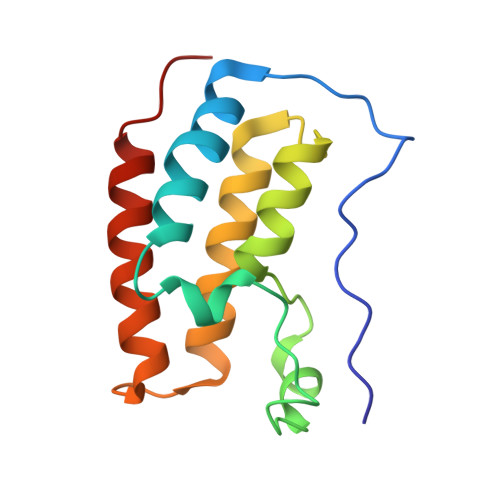Structure-Guided Design of Potent Diazobenzene Inhibitors for the BET Bromodomains
Zhang, G., Plotnikov, A.N., Rusinova, E., Shen, T., Morohashi, K., Joshua, J., Zeng, L., Mujtaba, S., Ohlmeyer, M., Zhou, M.-M.(2013) J Med Chem 56: 9251-9264
- PubMed: 24144283
- DOI: https://doi.org/10.1021/jm401334s
- Primary Citation of Related Structures:
4NUC, 4NUD, 4NUE - PubMed Abstract:
BRD4, characterized by two acetyl-lysine binding bromodomains and an extra-terminal (ET) domain, is a key chromatin organizer that directs gene activation in chromatin through transcription factor recruitment, enhancer assembly, and pause release of the RNA polymerase II complex for transcription elongation. BRD4 has been recently validated as a new epigenetic drug target for cancer and inflammation. Our current knowledge of the functional differences of the two bromodomains of BRD4, however, is limited and is hindered by the lack of selective inhibitors. Here, we report our structure-guided development of diazobenzene-based small-molecule inhibitors for the BRD4 bromodomains that have over 90% sequence identity at the acetyl-lysine binding site. Our lead compound, MS436, through a set of water-mediated interactions, exhibits low nanomolar affinity (estimated Ki of 30-50 nM), with preference for the first bromodomain over the second. We demonstrated that MS436 effectively inhibits BRD4 activity in NF-κB-directed production of nitric oxide and proinflammatory cytokine interleukin-6 in murine macrophages. MS436 represents a new class of bromodomain inhibitors and will facilitate further investigation of the biological functions of the two bromodomains of BRD4 in gene expression.
Organizational Affiliation:
Department of Structural and Chemical Biology, Icahn School of Medicine at Mount Sinai , 1425 Madison Avenue, New York, New York 10029, United States.
















